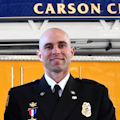Enhancing the Role of the Two-In/Two-Out Crew
During a recent lunch break at the station, I overheard one of our acting captains providing impromptu training to our crew in the kitchen. He was discussing the roles and responsibilities of two-in/two-out crews during a structure fire.
As I listened to his explanations of the additional duties and expectations of our department, I pondered a more effective way to deliver this training and to make the duties more easily remembered on the fireground. While the training session continued, I devised the 2 OUT 2 acronym.
OSHA compliance and more
Let me provide context. Our department operates in a suburban/urban area with a team of 20 firefighters who are split between two engines, a truck and four rescue ambulances. To comply with the Occupational Safety and Health Administration’s (OSHA) two-in/two-out requirement, we often assign one of our ambulance crews as the initial two-in/two-out team. Although the crew’s primary responsibility is to be prepared for rapid entry in case of a mayday or firefighter emergency, we train our two-in/two-out crews to perform additional tasks while they remain ready to act if needed.
At times, the assignment of two in/two out can be frowned upon by firefighters because of the perception of a lack of action. My department embraced the importance of this assignment, not only to comply with safety standards that are set forth by OSHA but to make the two-in/two-out team a multifaceted asset on the fireground that’s responsible for crucial tasks that can aid in the success of any structure fire.
Training of our two-in/two-out crews has one member remain near the entry point and the other member available to conduct additional tasks around the fireground while maintaining situational awareness to respond promptly if called.
2 OUT 2 broken down
Back to the training session in the kitchen: As the duties were explained, I noticed a pattern of assignments. They were grouped conveniently into pairs of two for each duty.
The 2 OUT 2 acronym is defined as follows:
2—Crew members ready to respond to a firefighter emergency
O—Operational lines (primary and backup)
U—Utilities secured (gas and electric)
T—Targets of opportunity (support the advancement of the first line, chase kinks, forcible entry, equipment support, etc.)
2—Two ways out/off (ensuring two ways for interior crews to exit and/or two ways off of the roof; in other words, softening the structure and placing ladders)
2 members. Upon receiving the two-in/two-out assignment, the two firefighters should coordinate who will be the entry point firefighter and who will be the mobile firefighter. It’s good practice for firefighters to preplan this, to increase their readiness and to avoid confusion when a fire call comes in.
The entry point firefighter is responsible for tasks that need completion at or near the entry point that’s nearest to the interior crew. The mobile firefighter is responsible for setting up the RIC pack at the entry point prior to beginning his/her additional tasks.
Operational lines. One crew member can assist with stretching and pushing the primary line from the exterior. If the first line is stretched to perfection and advancing smoothly, this same member can transition to preparing the backup line at the entry point.
Utilities. The second firefighter who’s assigned to the two-in/two-out crew can conduct a 360-degree size-up, assessing the structure and reporting any condition changes that weren’t reported originally by the first-due company officer. While on this lap of the structure, this crew member can ensure that the gas and electric utilities are secured.
Targets of opportunity. At this point, both firefighters should search for tasks that contribute to the firefighting efforts. This is the most fluid portion of the two-in/two-out assignment because of the nature of our profession. The fireground is an incredibly dynamic battlefield. Every fire need will be situationally driven.
2 ways out/off. During the 360-degree size-up, considerations for potential points of entry and exit in case of a firefighter emergency should be noted. If needed, after the completion of the 360, doors can be forced (provided that ventilation can be controlled), garage doors can be cut and ladders can be placed at windowsills. Additionally, if vertical ventilation was assigned, the two-in/two-out crew has the responsibility of providing an additional ladder for the roof team, to ensure two viable routes off of the roof.
Upping the value
Previously, my department relied on individual explanations of two-in/two-out tasks, but the 2 OUT 2 acronym now serves as a mental checklist for our two-in/two-out crews.
Embracing the importance and versatility of this assignment helps to ensure that two-in/two-out crews remain engaged—rather than standing idle—and represent a value add on the fireground. It can prove beneficial for smaller departments that face staffing challenges when responding to structure fires.
Of course, different departments might have their own standard operating procedures and fireground tactics that guide the expectations of their two-in/two-out crews. That said, sharing the premise of 2 OUT 2 is meant to encourage other departments to optimize their fireground operations, regardless of agency size or staffing levels.
About the Author

Jon Pedrini
Jon Pedrini is an 18-year member of the fire service. He currently holds the position of battalion chief within the Carson City, NV, Fire Department. Pedrini also is a sworn law enforcement officer, and within the County Sheriff’s Office, he holds influential roles as both a SWAT team leader and a TEMS commander. The tactical medical program that Pedrini established earned him recognition as the National Tactical Officers Association's Tactical Medic of the Year. In conjunction with his a focus on leadership, strategy, and tactics for fire and EMS, he serves as an instructor with Hortons and Hunt. Pedrini is a veteran of the U.S. Army, having served as a combat medic during multiple tours in Afghanistan.
